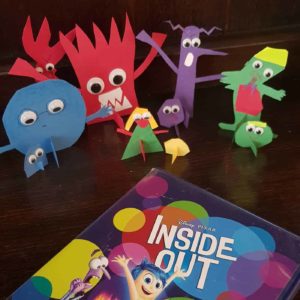
Last Friday we had a Movie Morning. We stayed in our pjs, set up chairs and cosy blankets in the lounge and ate waffles while we watched Inside Out.
It was 10 days until we moved house, and I wanted to watch this film with my children so that we could chat about some of the topics which it would cover.
We’ve watched Inside Out each year for our last three house moves. We watch it partly for the storyline – it’s about a girl who moves house and has to deal with the challenges of being somewhere new – but mostly for the insights into the role emotions can play in our lives. Now, I know that there’s probably a more eloquent and accurate TedTalk out there covering this topic, but for me and my children, now age 6 and 8, this film is a good way in for discussing important topics when doing a significant transition, such as moving home. It might also be good for changing schools, and churches, getting a new sibling, and other childhood transitions.
We watched the movie together, until when the ‘personality islands’ are introduced, five elements of Riley, the little girl’s, personality:
- family
- goofball
- honesty
- friendship
- hockey
I paused the movie and asked my children:
If you have five personality islands, what would they be?
Oh the fun! This is a great exercise to do at any time, as it helps everyone reflect on what makes them – their identity. This is such as important part of our lives, and knowing who we are, where we come from, and what we are part of, helps us to remain stable in times of transition.
The next time I paused the movie was when all the ’emotion’ characters, the people in Riley’s head, have had some time to show what they are like. They could have chosen many different emotions, and maybe you would choose other ones, but the ones in the movie are:
- Joy
- Anger
- Fear
- Disgust
- Sadness
We chatted about the different emotions, and their role, as depicted in the movie was. I asked what their anger character might look like, or their fear or their joy. My children also wanted to assign one emotion for themselves, which was interesting, especially as later in the movie we discover that they’re all important.
Since Riley’s memories are characterised by one of the emotions, you could also ask:
What family memory can you think of which could relate to one of these emotions? See if together you can cover all five. (Do you have a family broccoli incident too?!)
There’s then a part of the movie where we see Riley’s parents being quite busy with moving and disconnected from her. For me, this signalled to Be available! Be present! Keep routines the same, if at all possible.
They keep referring to her as their ‘happy girl, which just made me remember: Don’t put pressure on your children to be happy! When she displays ‘high levels of sass’ and is sent to her room, I wondered how I might have responded, and made a note to myself that ‘high levels of sass’ might be a signal that my children are finding things difficult and that they need understanding and assistance.
The next time I pause the movie was when BingBong (Riley’s imaginary friend whom Joy and Sadness meet when they are lost) loses his rocket. Joy tries to cheer him up by distracting him and trying to persuade him to move on, but Sadness sits down beside him and says:
I’m sorry they took your rocket.
She sits and listens as BingBong talks about what the rocket meant to him – something grief specialists call ‘holding space’ – and cries. She responds to him by saying, “I bet you and Riley had great adventures.” I rewound this, and asked my children to look specifically at what Sadness does and why it works better than what Joy does. It gave us some pretty awesome insights!
One of the boldest and saddest parts of the film is where BingBong and Joy are trying to use his rocket to get out of the dump, and the BingBong jumps off knowing that he is too heavy. We didn’t pause here, but it would be a lovely place to pause and ask:
Why did BingBong jump off? What might be BingBong for you?
Sometimes letting go of old things give us the power we need to do new things.
At the end of the movie, there’s a very emotional scene where sadness is allowed to touch all the core memories and Riley finally cries. And her parents finally hug her and talk with her about how they are feeling:
I miss Minnesota too.
They share memories of the things they are missing, and so, through sadness, comes connection and assistance and love.
And the new memory of this shared time is both gold and blue, Joyful and Sad.
My children were quite taken by the idea of memories of two colours.
We then went on to make little cardboard and googly eye versions of the emotions, and their cousins (don’t ask me!).
Could this help you?
